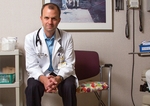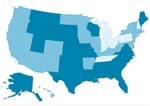business
How to help medical practice staff avoid burnout
■ To combat stress in the office, physicians and employees can talk about the problems they face and build teamwork.
- WITH THIS STORY:
- » External links
Physician burnout is well-documented. But doctors may not realize that if they or one of their practice colleagues is suffering from burnout, chances are that at least one staff member also has the same malady. Or it could be that a burned-out staff member is contributing to the doctor's own feeling.
Clues that an employee — or an entire staff — is suffering from burnout can be simple to spot. Once-model employees become surly. They might come to work exhausted on a recurring basis and are liable to snap at a co-worker or patient, or respond with icy silence when asked to add duties to an already full workload.
“Think of a light bulb,” said Kenneth Hertz, principal with MGMA Health Care Consulting Group. “No matter how many times you turn on the switch, nothing's coming on. In real serious burnout cases, they're dead in the water.”
Like physicians, staff feel the pressure of an increased workload and long hours. That's on top of whatever personal stress staff members bring to work. Working with a burned-out physician compounds the problem.
“It's really rough to be around a burned-out doctor,” said Dike Drummond, MD, a life and career strategist for physicians whose website, TheHappyMD.com, offers videos on how to avoid burnout. “They're cynical, sarcastic and wonder what's the use anymore. They think every problem can be solved by working harder.”
It can go the other way, too. A burned-out staff member may not be doing his or her job, resulting in more stress for the already overworked doctor.
In either case, physicians, staff and administrators need to work together to identify, treat and ultimately prevent burnout, experts say. Doing nothing could produce an office atmosphere that turns toxic, affecting patients' safety and sending them in search of a new doctor.
“I definitely believe patients can feel the pervasive negativity in the office when people are burned out,” said Liz Ferron, senior consultant and manager of clinical services with Workplace Behavioral Solutions in Minneapolis.
Economy, health system reform key stress factors
Physician Wellness Services and Cejka Search, a health care recruiter in St. Louis, jointly sent email surveys on physician stress and burnout in September 2011 to more than 100,000 doctors. In the more than 2,000 responses, 37.7% said they were severely stressed or burned out, and 62.9% said they were more stressed than three years ago.
The top three external factors cited were the state of the U.S. economy (51.6%), health system reform (46.4%) and policies of the Centers for Medicare & Medicaid Services (41.2%). The top three work-related factors were paperwork and administrative demands (39.8%), too many hours of work (33.3%), and on-call schedules and expectations (26.2%).
Experts say the same stress physicians feel is absorbed by staff, and that's causing more workers to consider heading out the door. A CareerBuilder survey conducted online in February by Harris Interactive of more than 500 U.S. health care workers and more than 240 U.S. health care employers found that 34% of health care workers plan to look for a new job in 2013, up from 24% in 2012. Sixty percent of health care workers say they are burned out on their jobs.
Nearly half of health care organizations — 46% — said they have been negatively affected by extended job vacancies, according to CareerBuilder.
Looking for solutions together
How can doctors be expected to solve their employees' burnout, especially if they are dealing with their own stress? Experts say physicians, staff and administrators can help one another, focusing on those factors that they can influence and that will take care of the physicians and employees physically and emotionally.
“The only way you can offer quality care to patients is if the doctors and staff are happy themselves,” Dr. Drummond said. “You need to put doctors and staff first for patient-centered care.”
He recommends a three-minute team huddle with physicians and staff twice a day to get everyone involved in optimizing the patient flow and the team's performance, a practice that he said will help make sure some potential problems are avoided.
“The receptionist can say who might be upset in the lobby, the doctor can say how he wants any open slots booked,” Dr. Drummond said. “Bond as a group. Put your hands in the middle like a sports team and say, 'Go team!' ''
If staff issues are because of external stresses, a practice can address those. Monthly “lunch and learn” sessions, which feature speakers talking about such issues as personal finance and sharing $5-a-meal recipes can provide important information to financially stressed workers, Hertz said.
Ferron said her organization is getting together small mixed groups of doctors and nurses. She said group members are asked about the stresses they face, what nurses need to know about the physicians, and how nurses could be helpful to doctors and vice versa.
“There was an immediate impact of increased trust. They came from different training and had different personality types, but now they understood one another,” she said.
Knowing your staff and showing them you care can go a long way, said Tony Rutigliano, senior vice president at Caliper Corp., a consulting firm in Princeton, N.J. Ask how they're doing. If someone's father has been sick, ask how he's doing. If you know a child is in ballet, offer to give that staffer time off to attend the recital.
Rutigliano said tremendous attention is spent on what went wrong in a practice. More time needs to be spent congratulating and recognizing staff and physicians for what they did right.
“You need to build a powerful coalition,” he said. “When someone is part of a 'we,' they're less likely to burn out. Plus, the ideas that can help most managers are in their staffs' heads. You just have to get them out.”












